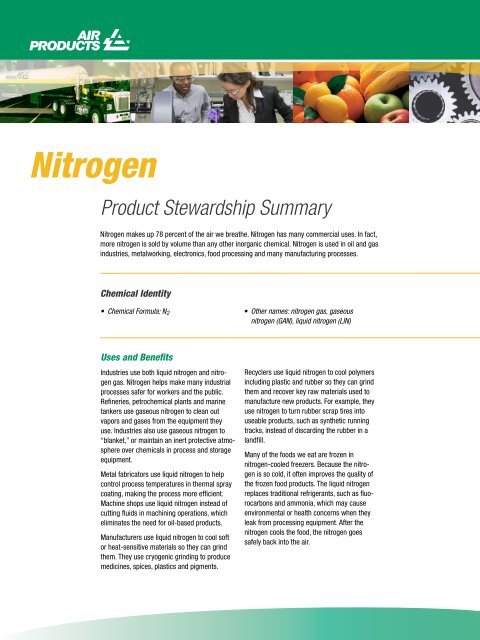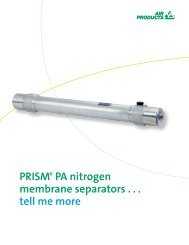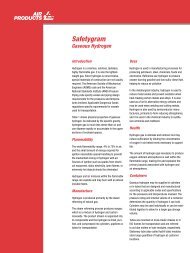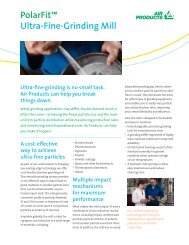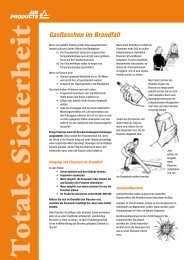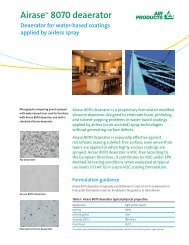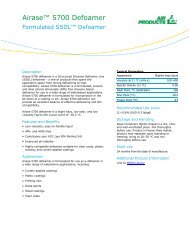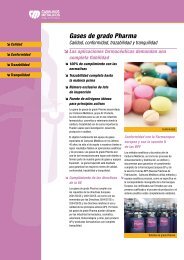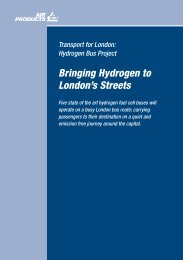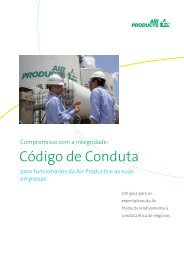Nitrogen - Product Stewardship Summary - Air Products and ...
Nitrogen - Product Stewardship Summary - Air Products and ...
Nitrogen - Product Stewardship Summary - Air Products and ...
Create successful ePaper yourself
Turn your PDF publications into a flip-book with our unique Google optimized e-Paper software.
<strong>Nitrogen</strong><br />
<strong>Product</strong> <strong>Stewardship</strong> <strong>Summary</strong><br />
<strong>Nitrogen</strong> makes up 78 percent of the air we breathe. <strong>Nitrogen</strong> has many commercial uses. In fact,<br />
more nitrogen is sold by volume than any other inorganic chemical. <strong>Nitrogen</strong> is used in oil <strong>and</strong> gas<br />
industries, metalworking, electronics, food processing <strong>and</strong> many manufacturing processes.<br />
Chemical Identity<br />
• Chemical Formula: N2<br />
Uses <strong>and</strong> Benefits<br />
Industries use both liquid nitrogen <strong>and</strong> nitrogen<br />
gas. <strong>Nitrogen</strong> helps make many industrial<br />
processes safer for workers <strong>and</strong> the public.<br />
Refineries, petrochemical plants <strong>and</strong> marine<br />
tankers use gaseous nitrogen to clean out<br />
vapors <strong>and</strong> gases from the equipment they<br />
use. Industries also use gaseous nitrogen to<br />
“blanket,” or maintain an inert protective atmosphere<br />
over chemicals in process <strong>and</strong> storage<br />
equipment.<br />
Metal fabricators use liquid nitrogen to help<br />
control process temperatures in thermal spray<br />
coating, making the process more efficient.<br />
Machine shops use liquid nitrogen instead of<br />
cutting fluids in machining operations, which<br />
eliminates the need for oil-based products.<br />
Manufacturers use liquid nitrogen to cool soft<br />
or heat-sensitive materials so they can grind<br />
them. They use cryogenic grinding to produce<br />
medicines, spices, plastics <strong>and</strong> pigments.<br />
• Other names: nitrogen gas, gaseous<br />
nitrogen (GAN), liquid nitrogen (LIN)<br />
Recyclers use liquid nitrogen to cool polymers<br />
including plastic <strong>and</strong> rubber so they can grind<br />
them <strong>and</strong> recover key raw materials used to<br />
manufacture new products. For example, they<br />
use nitrogen to turn rubber scrap tires into<br />
useable products, such as synthetic running<br />
tracks, instead of discarding the rubber in a<br />
l<strong>and</strong>fill.<br />
Many of the foods we eat are frozen in<br />
nitrogen-cooled freezers. Because the nitrogen<br />
is so cold, it often improves the quality of<br />
the frozen food products. The liquid nitrogen<br />
replaces traditional refrigerants, such as fluorocarbons<br />
<strong>and</strong> ammonia, which may cause<br />
environmental or health concerns when they<br />
leak from processing equipment. After the<br />
nitrogen cools the food, the nitrogen goes<br />
safely back into the air.
Physical <strong>and</strong> Chemical Properties<br />
<strong>Nitrogen</strong> has no color or smell. It does not burn.<br />
It’s slightly lighter than air <strong>and</strong> slightly water<br />
soluble. <strong>Nitrogen</strong> is inert, which means that it<br />
does not react with many materials. However, it<br />
can form compounds under certain conditions.<br />
For example, at high temperatures, nitrogen<br />
reacts with oxygen to form various oxides of<br />
Health Effects<br />
The air we breathe is 78 percent nitrogen. The<br />
balance is primarily oxygen, at roughly 21 percent.<br />
Oxygen is the only element in the air that<br />
supports life. Our body doesn’t use the nitrogen<br />
we breathe. We exhale about the same amount<br />
of nitrogen as we inhale.<br />
Higher levels of nitrogen or other gases in the<br />
air lower the amount of oxygen available to<br />
Environmental Effects<br />
We can manufacture <strong>and</strong> use nitrogen safely<br />
without harming the environment. In a way, we<br />
are only “borrowing” the nitrogen from the air.<br />
Most industrial applications can simply return<br />
Exposure Potential <strong>and</strong> Risk Management Measures<br />
Industrial Use<br />
We ship nitrogen as a high-pressure gas or a<br />
cold liquid. We often ship <strong>and</strong> store gases in<br />
liquid form, because they occupy much less<br />
space that way.<br />
We store <strong>and</strong> ship nitrogen gas in two different<br />
container sizes. Depending on how much<br />
our customer uses, we provide the gas in<br />
high-pressure cylinders <strong>and</strong> tubes. Industry<br />
guidelines cover the storage <strong>and</strong> h<strong>and</strong>ling of<br />
compressed gas cylinders. Workers should use<br />
sturdy work gloves, safety glasses with side<br />
shields <strong>and</strong> safety shoes when h<strong>and</strong>ling compressed<br />
gas cylinders.<br />
nitrogen. It can also form other compounds in<br />
the presence of catalysts.<br />
When cooled to extremely low temperatures<br />
(-321°F/-196°C), nitrogen exists in liquid form.<br />
To put that temperature into perspective, water<br />
freezes at 32°F/0°C.<br />
breathe. This can lead to dizziness, nausea,<br />
vomiting, loss of consciousness <strong>and</strong> death.<br />
No one should enter an area with less than<br />
19.5 percent oxygen without special breathing<br />
equipment to prevent suffocation.<br />
Liquid nitrogen is so cold that it can burn your<br />
skin, just like when a doctor uses it to remove a<br />
mole or a wart from your skin.<br />
the nitrogen to the air when they are finished<br />
using it. Plants <strong>and</strong> animals use nitrogen<br />
from the environment, <strong>and</strong> then they return<br />
it to the atmosphere. This nitrogen cycle is a<br />
critical process for life.<br />
We also store <strong>and</strong> ship liquid nitrogen in three<br />
different types of containers—dewars, cryogenic<br />
liquid cylinders <strong>and</strong> cryogenic liquid<br />
tanks. These containers are similar to heavy-<br />
duty vacuum bottles used to keep your coffee<br />
hot or your water cold. Because of its low<br />
temperature, liquid nitrogen should not come in<br />
contact with skin. For workers who h<strong>and</strong>le containers<br />
of liquid nitrogen, it is important to wear<br />
a full face-shield to protect the eyes <strong>and</strong> face.<br />
Workers should also wear clean, loose-fitting,<br />
thermal-insulated gloves; a long-sleeved shirt<br />
<strong>and</strong> pants without cuffs; <strong>and</strong> safety shoes.
To prevent suffocation, it is important to have<br />
good ventilation when working with nitrogen.<br />
Confined workspaces must be tested for<br />
oxygen levels prior to entry. If the oxygen level<br />
is lower than 19.5 percent, personnel, including<br />
rescue workers, should not enter the area without<br />
special breathing equipment that provides<br />
an independent source of clean breathing air.<br />
Regulatory Information<br />
Several regulations govern the manufacture,<br />
sale, transportation, <strong>and</strong> use of nitrogen.<br />
These laws vary by country <strong>and</strong> geographic<br />
region. You can find general regulatory information<br />
in the Material Safety Data Sheet.<br />
Conclusion<br />
A wide variety of industries use nitrogen. They<br />
can h<strong>and</strong>le it safely without harming the environment<br />
when industry <strong>and</strong> company guidelines<br />
are followed.<br />
Consumer Use<br />
The only use of nitrogen directly by customers<br />
is to inflate the tires on their cars. This operation<br />
is typically done at a service station or tire<br />
dealer, <strong>and</strong> does not generally involve direct<br />
h<strong>and</strong>ling of the nitrogen by the consumer. We<br />
do not sell nitrogen directly to consumers.<br />
Sources for Additional<br />
Information<br />
• <strong>Air</strong> <strong>Product</strong>s – MSDS<br />
• Compressed Gas Association<br />
• National Fire Protection Association<br />
• <strong>Air</strong> <strong>Product</strong>s Safetygrams
Contact Information<br />
Emergency Response System Technical Information Center<br />
• Tel 1-800-523-9374<br />
(Continental U.S. <strong>and</strong> Puerto Rico)<br />
• Tel 1-610-481-7711 (other locations)<br />
• 24 hours a day, 7 days a week<br />
• For assistance involving <strong>Air</strong> <strong>Product</strong>s <strong>and</strong><br />
Chemicals, Inc. gases <strong>and</strong> equipment<br />
We developed this <strong>Product</strong> <strong>Stewardship</strong><br />
<strong>Summary</strong> to give you a general overview of the<br />
chemical. This <strong>Summary</strong> is not meant to provide<br />
emergency response or medical treatment<br />
information. You can find in-depth safety <strong>and</strong><br />
health information on the Material Safety Data<br />
Sheet for the product.<br />
tell me more<br />
www.airproducts.com/summaries<br />
• Tel 1-800-752-1597 (U.S.)<br />
• Tel 1-610-481-8565 (other locations)<br />
• Fax 1-610-481-8690<br />
• E-mail gasinfo@airproducts.com<br />
• Monday–Friday, 8:00 a.m.–5:00 p.m. EST<br />
© <strong>Air</strong> <strong>Product</strong>s <strong>and</strong> Chemicals, Inc., 2009 (30665) 310-08-023-US-Dec08


